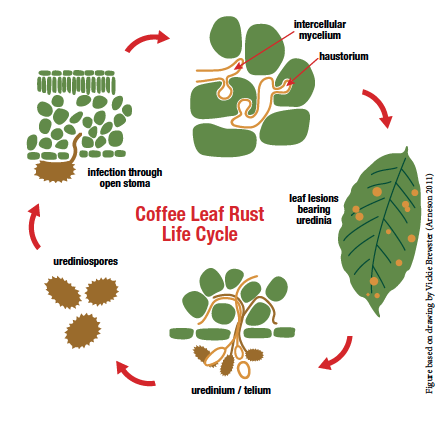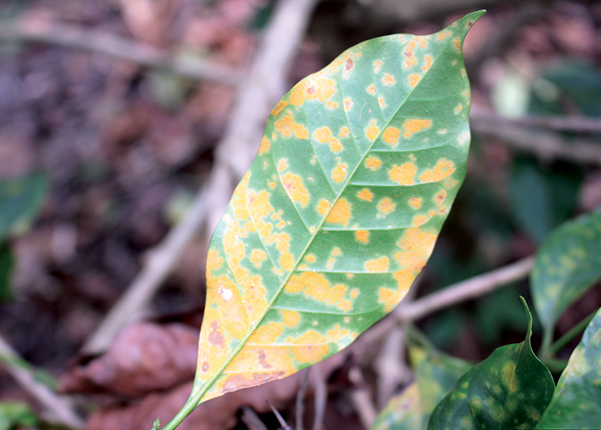Free printed copies of pest alerts are available.
Introduction
Coffee leaf rust, Hemileia vastatrix, was first described in 1869, and by 1990 the disease had spread to all major coffee production areas in Africa, Southeast Asia, and Central and South America. In late October 2020, coffee leaf rust was discovered on the island of Maui and has since been confirmed on all the major coffee-producing islands in the state of Hawaii, including Hawaii, Oahu, Lanai, Kauai, and Molokai.
Infection and Symptoms
The symptoms of the disease include large orange spots on the undersides of leaves, premature leaf fall and reductions in yield as high as 80%. Fungal spores germinate on the underside of the leaves and penetrate through the stoma. Mycelia grow intercellularly and produce haustoria that penetrate into plant cells, absorb nutrients, and eventually kill the cells. As the fungus grows within the leaf, it eventually forms uridia that contain new spores that erupt through other stomata, causing the characteristic yellow spots on the undersurface of the leaves.

Effects on Yield
Coffee leaf rust appears to affect coffee yield in several ways and over multiple years. Non-structural carbohydrates, such as soluble sugars and starch, in plants are crucial for fruit set and are related to photosynthetic rates and leaf area. Coffee leaf rust reduces photosynthetic rates because it defoliates the tree. The premature leaf drop causes the plant to use stored non-structural carbohydrates to replace the leaves to increase photosynthetic rate. But with less carbohydrate reserves, the plant may be unable to meet the carbohydrate requirements of the current crop leading to quality issues and overbearing stress on the plant. The symptoms of improper maturation of coffee berries includes yellow ripening and light and empty beans. In addition, carbohydrate may be withdrawn from young vegetative tissue resulting in the dieback of young shoots that will be the source of the subsequent crop. Progressive decline in yield and plant vigor occurs with continued rust infections over multiple years.
Coffee Leaf Rust Movement
Both people and wind are responsible for the global movement of coffee leaf rust. Humans have contributed to coffee leaf rust spread by growing susceptible Arabica cultivars globally. Closely planted susceptible coffee trees increase the likelihood of a local rust epidemic, and as farms enter the epidemic stage, they contribute more to the overall atmospheric load of rust spores and increase the likelihood of long-range dispersal. Spores can travel long-distances driven by wind (Bowden et al. 1971, Becker and Kranz 1977, Ferreira and Boley 1991), where the likelihood of spread is inversely proportional to distance because spore viability declines rapidly with time (Nutman & Roberts 1963). Commerce, trade, and tourism may contribute to coffee leaf rust spore movement, but these routes appear to be less important.


Host Plant Resistance
The genus Coffea includes more than 100 species that have a historical range across equatorial Africa, but Arabica coffee is native to only a small part of Ethiopia. Arabica coffee production has steadily increased since the 1500s to include all the major production areas seen today. By the late nineteenth century, two cultivars, Bourbon and Typica, dominated production. Newer cultivars without rust resistance are based on these two cultivars and are broken into the Bourbon and Typica groups. In the late 1950s, the Coffee Rust Research Centre, funded in-part through the U.S. Agency for International Development (USAID), identified a natural hybrid of Coffea arabica and C. canephora, known as the Timor hybrid with rust resistance. The resistance presumably derives from the Robusta (C. canephora) parent. Several research organizations like Brazil’s Instituto Brasileiro do Cafe, Columbia’s CENICAFE, Costa Rica’s ICAFE, and the United States’ World Coffee Research have developed rust-resistant cultivars using the Timor hybrid, Coffea liberica, and ancestral C. arabica from Ethiopia. These cultivars include Castillo, Paraiso, San Isirio, Starmaya, Tabi, and those in the Catimor and Sarchimor groups.
Resistance to fungal infection may involve multiple mechanisms. To date, a rapid hypersensitive cell death response of guard cells in the stoma and mesophyll cells after haustoria formation have been the best documented host plant resistance mechanism against coffee leaf rust. Cell death works well against biotrophic pathogens like coffee leaf rust that rely on live tissue for nutrients. There is some evidence for haustoria encasement that may be related to host incompatibility, and limited evidence suggests induced resistance mechanisms related to compounds such as gluconase and chitinase that attack important components of the fungal cell wall.
Management
Some management tools were already available in Hawaii before coffee leaf rust was discovered. Scouting and sampling plans to make management decisions, information about sanitation to prevent disease spread, and pruning protocols to limit disease severity were available before the discovery of the disease in Hawaii through the University of Hawaii at Manoa CTAHR Kona Cooperative Extension website (http://www.hawaiicoffeeed.com).
The likelihood of successful management of coffee leaf rust in Hawaii has recently improved through a combination of state and federal efforts. These include the emergency-use exemption for the fungicide mix containing pyraclostrobin and fluxapyroxad (Priaxor Xemium) and IR-4 projects focused on future registrations of additional fungicide mixes containing benzovindiflupyr and difenoconazole (Aprovia Top) and picoxystrobin and cyproconazole (Aproach Prima). Additional efforts include identifying the races of coffee leaf rust in the state, and importing and testing coffee cultivars with resistance to coffee leaf rust.
Credits
Authors
Baur ME, Kawabata AM, Nakamoto ST, Shriner S, Elliott S.
References
Arneson, P.A. 2011. Coffee Rust. The Plant Health Instructor. (http://dx.doi.org/10.1094/PHI-I-2000-0718-02)
Becker S, Kranz J. 1977. Comparative studies on the dispersal of Hemileia vastatrix in Kenya. J Plant Dis Prot. 84: 526-539.
Bowden J, Gregory PH, Johnson CG. 1971. Possible wind transport of coffee leaf rust across the Atlantic ocean. Nature 229: 500-501.
Ferreira SA, Boley RA. 1991. Hemileia vastatrix. Crop Knowledge Master published by the Dept of Plant Pathology, Univ of Hawaii (http://www.extento.hawaii.edu/kbase/crop/Type/h_vasta.htm). Accessed on Sept 21, 2021.
Nutman FJ, Roberts FM. 1963. Studies on the biology of Hemileia vastatrix Berl. and Br. [from Coffea arabica]. Trans Brit Mycol Soc, 46: 27-48
Additional Reading
American Phytopathogical Society website: http://www.apsnet.org/edcenter/disandpath/fungalbasidio/pdlessons/Pages/CoffeeRust.aspx
Hawaii Department of Agriculture Pest Advisory: http://hdoa.hawaii.gov/pi/files/2021/01/NPA-20-03-Coffee-leaf-rust1-21.pdf
World Coffee Research: http://WorldCoffeeResearch.org
This work is supported by the Crop Protection and Pest Management Program (2014-70006-22486) from the USDA National Institute of Food and Agriculture.
For information about the Pest Alert program, please contact the North Central IPM Center at northcentral@ncipmc.org.
January 2022

